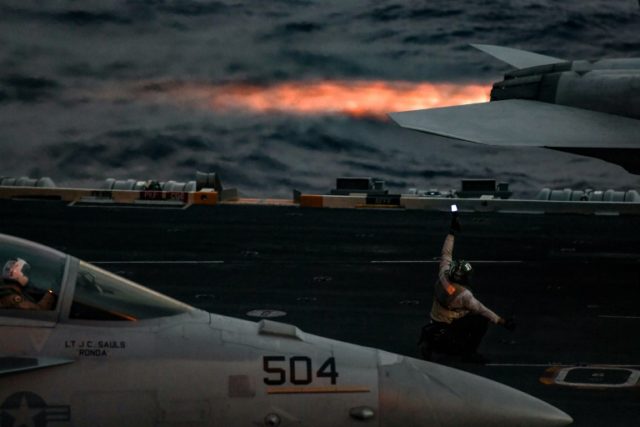Aboard USS Harry S Truman (AFP) – On the edge of a thunderstorm somewhere in the eastern Mediterranean, the US carrier Harry S. Truman rumbles as its fighters launch into the darkening sky.
With lightning bolts flashing in the distance, the 95,000-tonne nuclear-powered vessel named after the 33rd US president is waging a war thousands of miles away in Syria.
“It’s a pleasure to see a year’s worth of training in action,” Rear Admiral Gene Black, commander of the carrier strike group, notes from the ship’s bridge as the deadly choreography unfolds on the flight deck below.
Trailing fire and smoke, F-18 Super Hornet fighters blast off towards classified targets in rapid succession, alternating with refuelling planes and E-2D Hawkeye flying radars.
Sailing out from Norfolk, Virginia in April, the Harry S. Truman has been supporting attacks on Islamic State targets in Syria under Operation Inherent Resolve — a role it last played in 2016.
Ships this size are designed to “project American presence and power off any coast” according to the US navy.
“This is the biggest (strike group) to sail from the east coast in quite some time,” Black notes.
The carrier’s group currently includes a cruiser and four destroyers. A Russian warship hovers on the horizon. The strike group’s presence is an implied message to Moscow too.
“It’s a pretty potent force, with some of the latest capabilities the navy can put to sea,” the admiral adds.
Almost as long as the Empire State Building is high at close to 1,100 feet (335 metres), the flight deck teems with ‘rainbow warriors’ — sailors in brightly coloured shirts that designate their specific role in a system that, given the hazards, needs to run like clockwork.
Purple shirts fuel up the planes. Red shirts load the bomb and missile ordnance. Green shirts handle maintenance. Yellow shirts direct aircraft launch and recovery.
Working together, they can fire off two planes every 40 seconds during daylight, or 60 seconds at night.
“We’re planning on a seven-month deployment… we could go home in a month, we could extend for a year,” the admiral says.
– ‘See the world’ –
Below the deck hums a small city of over 5,500 people, many of them on their first deployment abroad.
“I came from a low-income home. I wanted to see the world… meet new people, get a free education basically,” says parachute rigger Caitlin Schumacher, a 25-year-old mother-of-three from Cleveland.
“It’s the most exciting thing that I’ve been a part of…it’s eye-opening,” says Dewayne ‘Hula’ Hooper, a 26-year-old pilot from Huntingtown, Maryland.
Hooper has been training for this role for three years. He has just flown his first mission over Syria — no details are forthcoming — yet still finds landing on a moving carrier daunting.
“It’s always scary, especially at night, but you want to come home,” he says.
Home, indeed. For months to come, the 70-aircraft behemoth will be the nearest thing for those on board.
“Deployment forces us to be a unit. We rely heavily on each other,” says Naomi L Goodwyn, chief of the officers’ mess hall.
“We become a real family. That’s what deployment does, it creates lasting memories, lasting friendships,” she stresses.
After a daily shift that can be as long as 12 hours, sailors unwind by watching movies, playing video games, and staying fit.
Workout machines abound on the ship, even on the navigation bridge.
The number of staircases on the carrier alone, however, make it a “floating stairmaster”, a crew member jokes.
– 17,000 meals a day –
To keep up morale, there are also karaoke nights, fitness classes, Lego building and the Truman Show — a homemade weekly TV show made by the sailors combining comedy and hard news.
Then there is the food. If an army is known to march on its stomach, this holds for sailors, too.
“We like to reward these guys every chance that we can,” says Brandi Royal, a 26-year-old galley officer from Denver, chopping bacon for the salad bar.
Every day, four meals are served across seven galleys — around 17,000 meals in all.
This includes 1,600 pounds of chicken, 160 gallons of milk, 30 cases of cereal and 350 pounds of lettuce, says Goodwyn, the mess hall chief.
And for anyone who has a birthday, they can look forward to a special meal that calendar month, she notes.
“Tablecloths, wine glasses, nice music, specialised meals like prime rib or lobster,” says Goodwyn.
“Everything in life is surrounded by food,” she says.
Everyone is also on a pretty tight leash. Loose lips sink ships.
Hooper, the pilot, is shut down by the navy press team just as he’s about to reveal what he fears most when in the air.
A question about drones and civilian casualties in the Syria bombings is also blocked.
“I don’t really think that’s, ah, his field of expertise,” the press officer interjects.

COMMENTS
Please let us know if you're having issues with commenting.